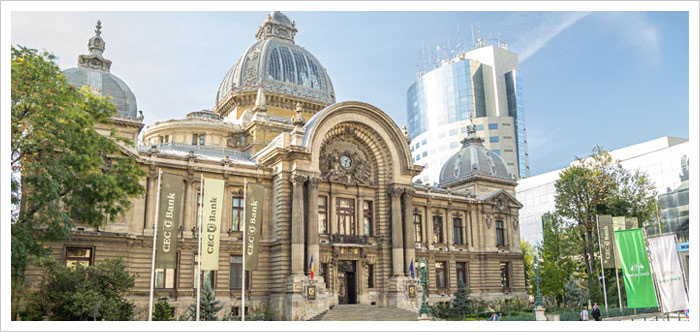
Official Name: Romania
Location: (Southeastern) Central Europe
Time Zone: Seven hours ahead of U.S. Eastern Standard Time (GMT + 2)
Area: 92,043 sq. miles (238,391 sq. km) - a little larger than the state of Minnesota
Flag of Romania: Three vertical stripes: blue, yellow and red.
Population: 21,890,000 (January 2024 - based on declared residence address)
Capital: Bucharest (București — pronunciation: boo koo re sh tea)
Largest cities (2025 population):
Bucharest (2,151,400), Iasi (387,100), Cluj Napoca (327,200),
Timisoara (325,300), Constanta (311,300), Galati (306,400), Craiova (299,700),
Brasov (289,500), Ploiesti (225,000), Oradea (221,400), Braila (200,100).
Romania's population lives in 320 cities and towns (56.4% of total population) and 12,956 villages.
Main Ethnic Groups:
Romanian 89.6%, Hungarian 6.1%, Gipsy 2.4%,
German 0.2%, Ukrainian 0.2%,
Lippovan (ethnic Russian Old Believers) 0.15%, Turkish 0.12%,
Tatar 0.09%, , Serbian 0.09% Slovak 0.07%.
Religions:
Christian Orthodox 81%, Roman Catholic 4.3%, Reformed 3%,
Greek-Catholic 0.7%, Unitarian 0.3%, Jewish, other.
Official Language: Romanian
Currency: Leu ( plural Lei — pronunciation "lay" — abbreviations: Lei or RON )
Climate: Temperate, four distinct seasons, similar to northeastern USA
National Flower: Peony. National Flower Day is celebrated on May 15, every year.
National Animal: Lynx
National Bird: European Golden Eagle (Aquila chrysaetos - Acvila in Romanian)
can be found in our Did You Know / Interesting Facts section.
Form of State: Romania is a semi-presidential democracy based on a bicameral Parliament:
the Chamber of Representatives or "Chamber of Deputies" (Camera Deputatilor) and
the Senate (Senat).
All members of the legislature are directly elected from Romania's 41 counties.
Under the semi-presidential system, the president is responsible for foreign and defense policy and controls appointments of prosecutors and the judiciary.
Legal system: Based on European models and Constitution of 1991.
Electoral System: Universal direct suffrage over the age of 18.
Parties must win at least five percent of the national vote to gain representation in the Parliament.
National Elections: December 2024 (presidential and parliamentary)
Head of State
President of the Republic, currently (Mr.) Klaus Werner Iohannis.
Romania's president can serve two consecutive five-year terms.
National Government
The government is led by the Prime Minister, nominated by the political party - or political alliance - with parliamentary majority,
approved by the President of Romania and confirmed by the Parliament.
The present Government has been nominated by the political alliance formed by the Social Democratic Party (PSD), and the National Liberal Party (PNL).
Head of the Government:
the Prime Minister, currently (Mr.) Ion - Marcel Ciolacu. (appointed: May 2023)
Political parties represented in Romania's Parliament following the December 6, 2020 elections:
Social Democratic Party (PSD), National Liberal Party (PNL), The Union for Romania (USR),
Democratic Union of Hungarian Ethnics in Romania (UDMR), Alliance of United Romanians (AUR).
Regional Government: Forty-one County Councils (Consiliu Judeţean).
Romania is a member state of the European Union (EU) and North Atlantic Treaty Organization (NATO)


